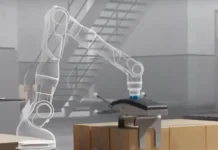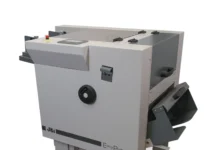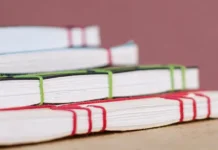by Anna C. Massey, Gateway Bookbinding Systems Ltd.

If you aren’t already doing plastic spiral binding, you really should be. Plastic spiral has become one of the most popular mechanical binding choices in today’s market. The durability of plastic spiral, the vast array of available colors from which to choose and advancements in the automation of the coil binding process have caught the attention of most binding consumers.
Base compound makes a difference
Most plastic spiral manufacturers produce coil using a PVC (polyvinyl chloride) compound. The required colorant is added during the extrusion process, at which time the PVC and colorant pellets are melted and mixed. The extruded filament is wound as a single strand profile onto spools.
Different profiles are produced for particular coordinating coil diameters. The spooled filament then is put through the forming process and manufactured into the specific diameter, pitch and length of coil that is required.
Although most plastic spiral binding utilizes this PVC base compound, what goes into that compound can differ between manufacturers. Every compound will have different levels of additives that can and do affect the finished product. Additives such as impact modifiers help insure the coil is durable and will maintain its shape. Lower grade materials are not, however, as strong and may contain fillers that bulk up the product with no actual benefits. Lead-free and phthalate-free spiral binding also are very important features, especially when producing childrens books.
All coil is not created equal

Different coil manufacturers can and do use different profiles or gauges of filament to produce the various coil diameters. A 10mm coil may be produced with a filament of 2.0mm (.080″). Others may use a thinner filament, like 1.8mm (.072″) or even 1.5mm (.060″).
If you are price shopping for a potential coil supplier and are strictly looking at the cost on the printed price list, you may not be comparing “apples to apples.” If a manufacturer is using a very thin filament to produce its product, the price list will look more appealing because less material is being used to produce the coil. It is important to know what profiles of plastic a coil supplier uses to make its various coil diameters.
Plastic spiral binding that is very thin can cause problems during the insertion process. Plastic spiral that is too thick also can cause difficulty when inserting, which will reduce production numbers.
Recommendations can and should be made based on the book thickness, with the proper punch-hole size and shape being discussed. The type of coil inserting equipment being used also makes a difference.
A sharp lead edge on the coil is another important factor when the coil is running through the punch holes. It also has been proven that a “reverse cut” on the larger diameter/thicker profile coils will aid with coil insertion even further. Talk to the supplier to understand the options that are available.
Pitch – the most misunderstood term
You’ve heard the term and have probably been asked, “What pitch do you use?” Its a simple five-letter word, but it is – without a doubt – the most misunderstood term within the industry.
The dictionary definition of pitch, as it pertains to machinery, is the distance between corresponding points. In the world of plastic spiral binding, pitch is easiest to illustrate through punch patterns. There are a number of different pitch options available, and they are not all the same.
Unlike double-loop wire binding with the simple 3:1 and 2:1 pitch choices or comb binding with the standardized rectangular-shaped 19 holes on the 11″ edge, coil binding is a little different.
The various pitch choices for coil binding have come about because of a combination of originating European manufacturers (that work with the metric system) and North American manufacturers that utilize traditional Imperial measurements.
For simplicity’s sake, remember 1″ equals 25.4mm.
.2475″ Pitch – This is fast becoming the pitch of choice. This hole pattern fits the best on the common 11″ and 8.5″ (as well as the European A4 and A5) binding edges without the need to pull pins or trim to center. At first glance, the .2475″ pitch looks a lot like four holes within the inch, but it is indeed different than the traditional True 4:1. The .2475″ pitch also is most commonly available with a 5x4mm oval punch hole.
True 4:1 Pitch (also known as .250″ or ¼” pitch) – True 4:1 is probably the most common of pitches. Many North American equipment manufacturers work with this pitch. It literally means that there are exactly four punch holes within every 1″. Although a common pitch, it does mean that punch pins need to be pulled in order to center this pattern on the 8.5″ or 11″ edge.
6mm Pitch – Common amongst European equipment manufacturers, the 6mm pitch does not mean six holes per inch. It means that there are 6mm from the center of one hole to the center of the next hole. It equates to four and a partial hole within every 1″.
5:1 Pitch – Although very common 20 years ago, the 5:1 pitch (five holes per inch) rarely is utilized these days because it really only worked well for thin projects. Any book thicker than 3/8″ became a challenge to bind with such tight spacing and a typically smaller punch hole. There even is a metric 5mm pitch that is close to a 5:1 spacing. Few equipment manufacturers offer these options any more.
Wider 3:1 or 2.5:1 Pitch – These wider pitch options are literally worded. The 3:1 pitch means that there are three holes within every 1″ measurement. The 2.5:1 means just that – 2 1/2 holes per 1″. These pitch choices commonly are used when binding thicker books. The wider spacing makes coil insertion much easier. It also is recommended that the punch hole itself be a larger 6.5×5.5mm oval shape. This larger punch hole provides the coil more room to wind its way through. That size of punch hole can and does improve productivity by a good 40 percent.
There even are more pitches available – like a .312″ pitch or an 8mm pitch. These were common with metal spiral binding and sometimes still are used with plastic spiral.
The right pitch for a binding job primarily depends upon two factors – the books thickness and length of the binding edge. For example, even though the .2475″ pitch fits best on an 11″ binding edge, if a job with a 10 7/8″ binding edge is being produced on automated equipment and trimming is not an option, then a 6mm pitch would be better suited for the job.
Talk to the plastic spiral binding supplier. It is the suppliers job to make sure customers are set up with the most productive equipment available – within budget – that will enable efficient and successful handling of coil binding needs.
Anna C. Massey is director of marketing for Gateway Bookbinding Systems Ltd., Winnipeg, MB, Canada. For more information, call 800.665.7884 or visit www.plastikoil.com.




